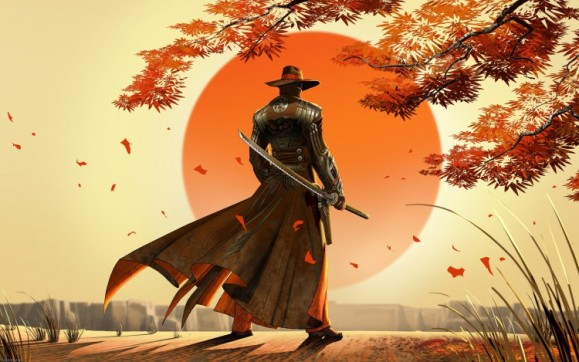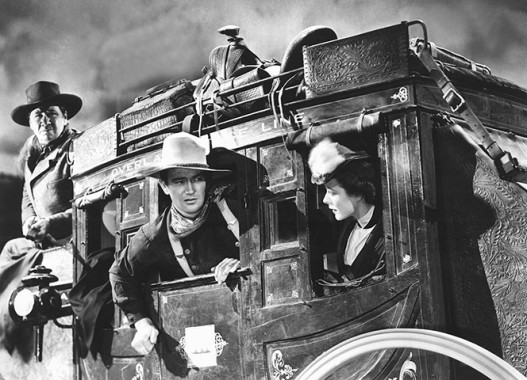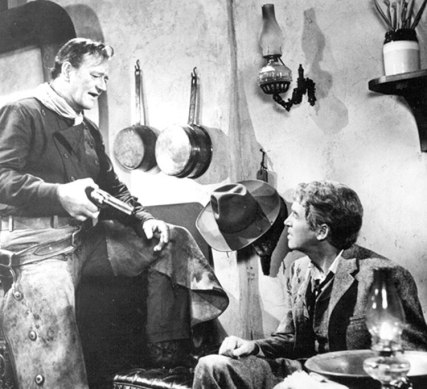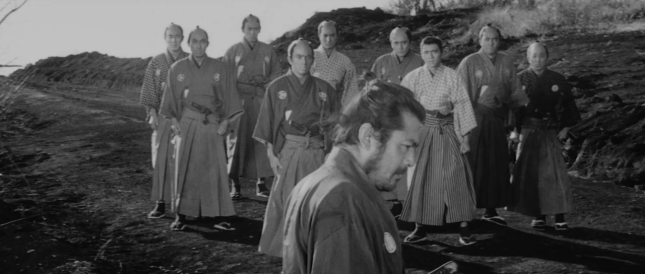American and Japan has had lots of cross-cultural exchanges. We gave them baseball, karaoke, and cheeseburgers. They gave us karate, sushi, and women-shaped body pillows. One of the most prominent exchanges was through our films, particularly Westerns. The quintessentially American genre unexpectedly impacted Japanese filmmaking through legendary director Akira Kurosawa. He cited John Ford, director of Stagecoach and The Searchers, as one of his primary inspirations. His love of the Western backdrop was showcased in his ‘Chambara’ (“sword-fighting“) films Seven Samurai and Yojimbo. Both films dealt with hardened soldiers fighting equally hardened villains against the endless countrysides of Japan. These films were so iconic that they inspired Western remakes themselves: The Magnificent Seven (1960) and A Fistful of Dollars, respectively. This begs the question: what connects the two genres so closely?
Stagecoach (1939)
To start: lets look at the work of Ford. While the Western genre existed well before his influence, Ford turned it from light fare to grand opera. His Western frontier stretched beyond just shootouts to the very core of human nature, especially class. Stagecoach focused on a group of obvious class caricatures – a greedy banker, a haughty socialite, etc – riding on the titular stagecoach towards a far off destination. We see class distinctions at play as one of the occupants, a prostitute, is only on the stagecoach due to her being kicked out of town for her profession. Likewise, she’s treated like a disease during the trip. That is until the arrival of fugitive ‘The Ringo Kidd’ played by John Wayne in his breakthrough role (he’s in the middle of the photograph). He joins the stagecoach party to avenge his father and brother’s murders at the hands of outlaws living at their destination. Along the way, he falls in love with the prostitute without interest of her background. He, of course, is treated as badly as her due to his criminal status. This is despite his competency in a shootout, shown in a Navajo raid on the stagecoach and his eventual defeat of his family’s killers. Once their trip ends and he learns of his love interest’s profession, he still decides to marry her and they live happily ever after.
Unlike many Western heroes before him, The Ringo Kid was neither a ‘black hat’ or ‘white hat’. He was on the lowest rung of society but had an ethic that transcended its highest rung. He believed in honor and equality; risking his life for vengeance and seeing past his love’s low station. Several culture theorists say that the Western Gunslinger archetype is America’s version of the knight. Both figures of power and discipline; the gunslinger is distinguished by his democratic appeal. Rather than being of noble birth, the gunslinger merely needs to be handy with a revolver. He can be a man with no name.
Seven Samurai (1954)
Likewise, Kurosawa’s heroes didn’t even need to be actual samurai. Seven Samurai‘s protagonists don’t serve a master (samurai means “those who serve in close attendance to the nobility“) making them technically ‘Ronin’, which basically means ‘vagrant”‘. They are hired by a farming town to drive off a group of bandits who constantly rob them. We see that the samurai’s allegiance isn’t due to money, but the destitution the farmers had been reduced to under the bandits’ tyranny. The not-so-subtle parallel is evident when looking at the time period: 1587 Japan was going through it’s “Warring States” period where the lower class objected against elitist oppression. The government was the real life bandit. As with Stagecoach, the heroes of Seven Samurai straddle the line of distinction and commonality: they were government officials themselves until circumstance left them as vagrants. They had the discipline of their former station along with common wisdom.
Not all of the connections between the two genres are positive. Part of the reason Samurai and Gunslingers were becoming increasingly more “common” was because they were losing their status in both fiction and reality. Seven Samurai showcases the degradation real-life samurai faced as social hierarchy was being challenged. Not only were they reduced to vagrants, but their moral impunity was beginning to lapse as well. Kikuchiyo – one of the Seven who was an orphaned farmer and never even a real samurai – calls out the other six when they consider killing the farmers for robbing other samurai:
“[Farmers] pose as saints but are full of lies! If they smell a battle, they hunt the defeated! Farmers are stingy, foxy, mean, stupid and murderous! But then, who made them such beasts? You did! The samurai did it! You burn their villages! You destroy their farms! Steal their food! Force them to labor! Take their women! And kill them if they resist! So what should farmers do?”
Despite the romance of samurai lore, they were kind of dicks. Like knights, samurai were noblemen first and gentlemen second (if at all). As Kikuchiyo alludes to, many abused their stations. Hell, for all we know, the bandits who’ve been robbing them could have been ex-samurai: it wasn’t that uncommon for unemployed samurai to resort to crime. This narrative reflects a changing cultural attitude in 50’s Japan. Post-World War 2, Japan took a hard blow to its nationalism. The government lacked much of the moral high ground it once had. The Samurai was iconic of the nation, therefore it was only appropriate that they would lose much of their veneer as well.
The Searchers (1956)
Despite being on the winning end of World War 2, America too began to question the heroism of their icons. As with samurai, real-life “Wild West” gunmen were mostly ex-soldiers; veterans of the Civil War who fought for the Confederacy. As you can imagine, the burgeoning civil rights movement made these guys look pretty bad in retrospect. For the Western hero, racism often replaced the samurai’s classism. Ford’s The Searchers has as it’s protagonist another iconic John Wayne character: Ethan Edwards. Like The Ringo Kidd, Edwards is implied to have a criminal past after his Civil War service. Unlike Ringo, he’s not nearly as liberal in his sentiments. Edwards is established as prejudiced towards Native Americans when he rejects his adopted nephew due to his partially Comanche heritage. This isn’t helped much when most of his family is killed by Comanches who then kidnap his two nieces. In his quest to retrieve them, he resorts to tactics such as desecrating Comanche graves in order to keep them from going to the afterlife and driving off their cattle to starve them. He even uses his nephew as bait to lure out an attacker. As the quintessential Western hero, Wayne’s trajectory from noble cowboy to racist sociopath is pretty jarring. Just as the Samurai represented unsavory elements of Japan’s past, The Searchers signalled a growing cynicism towards the “good ol boys” of classic Westerns.
The Man Who Shot Liberty Valance (1962)
Ford’s next major western – The Man Who Shot Liberty Valance – established the death of the classic Western hero. The film takes place in 1910 after the death of veteran gunslinger Tom Doniphon, yet another iconic role of John Wayne. His body is visited by Senator Ransom Stoddard, played by Jimmy Stewart (to the right of the photograph), who begins to recount to a local newspaper the story of their conflict with local outlaw Liberty Valance several decades prior. After being assaulted by Valance, Stoddard vows to stop his tyranny. Of course, he attempts to do this legally, which is scoffed at by Doniphon, who believes the only way to put an end to his gang is with a bullet. Their ideological conflict is the centerpiece of the film: Stewart tries to civilize the town as a lawyer, educator and eventual governor candidate, while Wayne clings to the ways of the cowboy. They even end up fighting over the same woman. What makes this different from previous Wayne films is that he doesn’t get to be the hero. Stoddard succeeds in bringing civics to the frontier town, allowing it to resist Valance’s criminal control. He gets the girl too. But the real tragedy is that the actual shooting of Valance, which was attributed to Stoddard, was actually Doniphon’s attempt to save Stoddard’s life and boost his reputation. Doniphon’s heroic act allows for Stoddard to have an upward climb to Senator. What does Doniphon get? He loses his girl, his ranch, his sobriety and is forgotten in history. Yippie ki yay. Even though men like Stoddard began the work that would bring the frontier into civility, it was men like Doniphon that allowed those men to reach that point. And yet, like a gun-toting Moses, Doniphon never got the enjoy the fruits of his labors.
By the late 60’s, the few Westerns being made were increasingly subversive of the genre. As the iconic John Wayne became a dinosaur, he was replaced by a much darker gunslinger: Clint Eastwood.
A Fistful Of Dollars (1967)
Whereas John Wayne’s heroes were always local protectors, Eastwood was always an anonymous drifter. Whereas Wayne had clear intent, Eastwood schemed. The film that established this new kind of gunslinger was Sergio Leone’s A Fistful Of Dollars (the first of the Man With No Name trilogy). But the film that established this hero beforehand was the film A Fistful Of Dollars was an adaptation of: Kurosawa’s Yojimbo.
Yojimbo (1961)
Before there was Clint Eastwood, there was Toshiro Mifune, one of the stars of Seven Samurai. His character of Kikuchiyo established him as being able to play honorable vagrants. This continued in Yojimbo, where he plays a nameless drifting ronin who plays two violent gangs against each other in order to save a town. We’re not given a clear rationale for why he wants to do so, but he helps the town nonetheless. Rather than gaining a wife or getting paid, he simply moves on once he’s done. As with Tom Doniphon in The Man Who Shot Liberty Valance and the Man With No Name, being a lone samurai hero turns out to be a pretty thankless job. As Kambei Shimada of Seven Samurai alludes to at the end, what these men accomplish is only beneficial to ‘The People’ and not them. Since these soldiers were meant to be in service to the public (at least in theory), it makes sense that these idealized heroes were a catharis for filmmakers and audiences. The soldier acts for the good of The People and then fades away into obscurity like a good boy. This idea is explored in Yojimbo‘s sequel Sanjuro.
Sanjuro (1962)
Once again, Mifune’s nameless ronin has to help out those weaker than him. Ironically, they are nine well-meaning but incompetent samurai under threat of a corrupt superintendent. As you can tell, the implied politics of Seven Samurai is quite explicit here. The ronin protects the samurai from the superintendent’s forces in his usual lethal way. Except this time, we see that his actions have more personal consequences. He’s called out by the wife of the samurai clan’s master, who says he’s like a “glittering sword…but a sword should stay within it’s scabbard“. This statement is contradictory: putting the sword in its scabbard not only hides its “glitteriness”, it renders it useless. She’s asking the ronin to nullify himself. Despite his abilities, men like him are a destructive breed who need to be contained and not celebrated. Upon hearing this, he attempts to use less violent methods, but is forced to kill when the other samurai act out their incompetence. As in The Man Who Shot Liberty Valance, martial and civil authority must work in concert to achieve the best ends. Unfortunately, the best ends mean a world without soldiers. Once the superintendent is defeated, the ronin leaves before he can be invited to the clan. Their master thinks that the ronin knew he would be unable to serve a master. More importantly, their master thinks he shouldn’t be part of the clan due to his wildness. Sure enough, once the other samurai catch up with the ronin, they see that the superintendent’s top man, an equally strong warrior, is unwilling to let him leave without a duel to the death.
The ronin refuses out of respect, but the man doesn’t relent. So they duel.
Rather than celebrating another victory, the ronin departs in anger and sadness. He chastises the samurai for praising his abilities and bitterly tells them to “stay in their scabbards“. He then walks away, never to be seen again. Not only does our hero get nothing for his efforts, we realize just how tragic a life of constant battle really is. Even though he wanted to be the man the master’s wife wanted him to be, he’s unable to fit into their world. As with Doniphon, the ronin helps usher in a more civil and democratic Japan that he doesn’t belong in.
Despite cultural boundaries, people often have more in common than they think. While the lone gunman cast out from society might seem like a particularly American notion, we see that it’s not too far off from the former samurai who lost his position in the world. Time and circumstance can often be great equalizers. The gunslingers and samurai were once paragons of virtue, but history often casts them as savages. At best, they’re regarded as nostalgic ghosts of the past. But history is multi-faceted. While we might realize that these guys probably shouldn’t exist now, we also realize we’d be in deep shit if they never existed. For better or worse, they helped carve their respective nations (when not carving up each other). And as society evolves, figures such as these will be part of our cultural fabric. Just replace The Ringo Kidd with John McClane or Yojimbo with Luke Skywalker. Despite some unsavory elements, these archetypes represent several things we hold dear: discipline, bravery, and most importantly, heroism. The best we can do is accept the good and the bad in order to appreciate our collective history.
For more thoughts on film and history:
You Only Live Twice: The Deconstruction of James Bond
The Unfortunate Undeath of Chivalry: The Implications of Romance in Hollywood
Django Unchained: Reflections on Calvin Candie
The Decay of the American West in Texas Chainsaw Massacre
Black Masculinity in Narrative Media: Noble Savages










